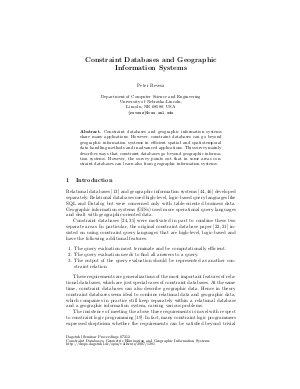Constraint Databases and Geographic Information Systems
Author Peter Revesz
-
Part of:
Volume:
Dagstuhl Seminar Proceedings, Volume 7212
Part of: Series: Dagstuhl Seminar Proceedings (DagSemProc) - License:
 Creative Commons Attribution 4.0 International license
Creative Commons Attribution 4.0 International license
- Publication Date: 2007-12-17
File

PDF
DagSemProc.07212.6.pdf
- Filesize: 124 kB
- 9 pages
Document Identifiers
Subject Classification
Keywords
- Constraint databases
- geographic information systems
- moving objects
- spatiotemporal data
- visualization
Metrics
- Access Statistics
-
Total Accesses (updated on a weekly basis)
0PDF Downloads0Metadata Views
Abstract
Constraint databases and geographic information systems share many applications. However, constraint databases can go beyond geographic information systems in efficient spatial and spatiotemporal data handling methods and in advanced applications. This survey mainly describes ways that constraint databases go beyond geographic information systems. However, the survey points out that in some areas constraint databases can learn also from geographic information systems.
Cite As Get BibTex
Peter Revesz. Constraint Databases and Geographic Information Systems. In Constraint Databases, Geometric Elimination and Geographic Information Systems. Dagstuhl Seminar Proceedings, Volume 7212, pp. 1-9, Schloss Dagstuhl – Leibniz-Zentrum für Informatik (2007)
https://doi.org/10.4230/DagSemProc.07212.6
BibTex
@InProceedings{revesz:DagSemProc.07212.6,
author = {Revesz, Peter},
title = {{Constraint Databases and Geographic Information Systems}},
booktitle = {Constraint Databases, Geometric Elimination and Geographic Information Systems},
pages = {1--9},
series = {Dagstuhl Seminar Proceedings (DagSemProc)},
ISSN = {1862-4405},
year = {2007},
volume = {7212},
editor = {Bernd Bank and Max J. Egenhofer and Bart Kuijpers},
publisher = {Schloss Dagstuhl -- Leibniz-Zentrum f{\"u}r Informatik},
address = {Dagstuhl, Germany},
URL = {https://drops.dagstuhl.de/entities/document/10.4230/DagSemProc.07212.6},
URN = {urn:nbn:de:0030-drops-12810},
doi = {10.4230/DagSemProc.07212.6},
annote = {Keywords: Constraint databases, geographic information systems, moving objects, spatiotemporal data, visualization}
}
